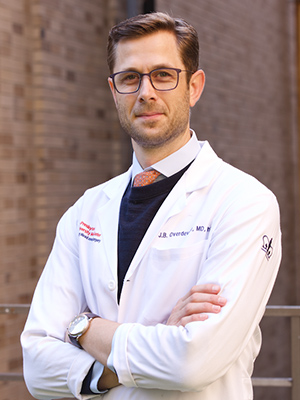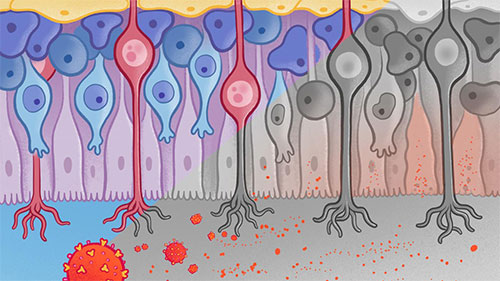Loss of smell, or anosmia, has been one of the most commonly reported symptoms related to COVID-19 infection, but it is also among the least understood. Now, a recent study led by a multidisciplinary team of researchers from Columbia has revealed a molecular-level mechanism that likely explains anosmia in SARS-CoV-2 patients.
Loss of smell, or anosmia, has been one of the most commonly reported symptoms related to COVID-19 infection, but it is also among the least understood. Now, a recent study led by a multidisciplinary team of researchers from Columbia has revealed a molecular-level mechanism that likely explains anosmia in SARS-CoV-2 patients.
While olfactory deficits are common in upper respiratory infections, the mechanism by which the SARS-CoV-2 triggers these symptoms has been among the many unanswered questions surrounding a virus which, while infecting only a small number of cells in the body, causes damage across a number of organ systems. Meanwhile, patients have continued to contend with successive waves of widespread SARS-CoV-2 infections, with the majority experiencing olfactory loss and recovering in weeks. However, approximately 10 percent suffer from persistent olfactory dysfunction beyond six months.
Dr. Jonathan Overdevest
“The research challenge before COVID-19 was the low prevalence of olfactory loss within a younger, healthy population. Oftentimes smell loss develops relatively slowly, progressing gradually,” says Jonathan Overdevest, MD, an expert in rhinology and minimally invasive skull base surgery in the Department of Otolaryngology – Head and Neck Surgery at NewYork-Presbyterian/
“We did an initial assessment within the New York metro area of about 2,000 individuals with COVID,” notes Dr. Overdevest. “Within that group, about 70 percent reported self-perceived olfactory loss at the time of their COVID diagnosis. In a follow-up of those individuals who lost their sense of smell, some level of olfactory dysfunction persisted in approximately 10 percent at about six months. And that's where it transitions from olfactory loss to olfactory dysfunction.”
Dr. Overdevest works closely on olfactory research and in particular, COVID chemosensory loss, with Stavros Lomvardas, PhD, the Herbert and Florence Irving Professor at Columbia’s Zuckerman Institute and Professor of Biochemistry and Molecular Biophysics and Neuroscience; Marianna Zazhytska, PhD, a postdoctoral research scientist in the Lomvardas Lab; and Stuart Firestein, PhD, Professor of Neuroscience, Department of Biology at Columbia.
SARS-CoV-2 virus infects sustentacular cells of the olfactory epithelium and disrupts chromosome arrangement in olfactory neurons, leading to anosmia. (Credit: Dr. Stavros Lomvardas, Columbia’s Zuckerman Institute)
In the current study, the Columbia researchers collaborated with scientists at other major academic medical institutions in New York, California, and Texas, to explore the molecular impact of SARS-CoV-2 infection in an animal model with similarity in pathogenesis and immunological responses to humans as compared to an examination by Dr. Overdevest of olfactory tissue from people who had died of COVID-19. The animal and human studies reinforced each other and pointed directly to how infections interrupt smell.
Findings from the study uncovered that rather than the virus directly infecting the olfactory sensory neurons or anosmia being a result of rhinorrhea or nasal congestion as in many other upper respiratory infections, SARS-CoV-2 takes a circuitous and ultimately more destructive route by infecting the structural supporting sustentacular cells.
Findings from the study, published in the March 17, 2022 issue of Cell, uncovered that, rather than the virus directly infecting the olfactory sensory neurons (OSNs), or anosmia being a result of rhinorrhea or nasal congestion as in many other upper respiratory infections, SARS-CoV-2 takes a circuitous and ultimately more destructive route by infecting the structural supporting sustentacular (SUS) cells. This sets in motion a process of rapid reorganization of OSN nuclear architecture, resulting in significant downregulation of key genes of the olfactory receptor and molecules related to olfaction. “This process of genomic damage seems to allow SARS-CoV-2 to create lasting neurological symptoms achieved by altering the physiology and function of OSN cells while lacking an apparent ability to infect them,” says Dr. Overdevest.
Micrograph of human olfactory epithelium from COVID-19 patient labeling SARS-CoV-2 in magenta and olfactory neurons in green. SARS-CoV-2 is detected in the apical layer and does not colocalize with olfactory neurons. (Credit: Albana Kodra, Lomvardas Lab, Columbia’s Zuckerman Institute)
Implications for Broader Olfactory Research
Dr. Overdevest will also be investigating the interaction and impact of chemosensory dysfunction related to neurocognitive and neuropsychiatric deficits in patients longitudinally with a five-year horizon. The focus is on the subset of SARS-CoV-2 patients for whom olfactory dysfunction lingers with symptoms termed by the NIH as post-acute sequelae of SARS-CoV-2 (PASC), or, colloquially, long COVID. “In our next phase of research, we are seeking to better understand why some of these individuals have objectively persistent olfactory and gustatory issues at a molecular level compared to individuals who have fully recovered,” says Dr. Overdevest. “Much of what we are trying to do at the moment is to identify clearly what is mechanistically dysfunctional in hopes of identifying possible pathways that are interrupted, resulting in aberrant expression and/or limited expression of olfactory receptors during the recovery process. This information will potentially be insightful in terms of identifying targets for intervention.”
While there is significant scientific research still needed related to PASC, Dr. Overdevest is steadfast in his motivation by a dedication to patient care for those dealing with this challenge now. “Post-acute sequelae of COVID presents with a broad range of symptoms, with many neurologic manifestations, including headache, fatigue, general memory loss, other tactile and sensory alterations, as well as brain fog,” adds Dr. Overdevest. “Headache, fatigue, and brain fog constitute the major symptoms that we’re seeing in patients undergoing follow-up for long COVID. Wrapped up in this is olfactory dysfunction, where we are studying the correlation among these issues in an attempt to determine causation. Smell is, at its base, a quality-of-life issue accompanied by the more practical safety concerns of losing olfactory warnings that protect humans from danger, including smoke, fire, or pathogens in spoiled food.”
Dr. Overdevest, in continuing collaborations with Dr. Lomvardas, Dr. Zazhytska, and Dr. Firestein, are working to shift their focus from creating a fundamental understanding of how patients lose their sense of smell to a better understanding of why they were persistently having either smell loss (hyposmia); or olfactory dysfunction, which can manifest as either an altered perception of an odor when presented to the nose (parosmia); or the perception of an odor when there’s no odor presented to the nose (phantosmia).
Dr. Overdevest also has an ongoing collaboration with Davangere P. Devanand, MD, Director of Geriatric Psychiatry at NewYork-Presbyterian/
“The invaluable collaborations that bring together a diversity of skills and research interests will continue to bridge the gap between basic molecular understanding and meaningful improvements in outcomes for patients struggling with olfactory dysfunction,” says Dr. Overdevest.







